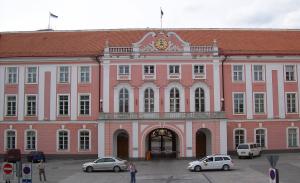Country reports
On Sunday, 1 March 2015, Estonian citizens elected their 13th state assembly, the Riigikogu. Similar to the elections four years earlier, the incumbent liberal-conservative Reform Party led by the 35-year-old Prime Minister Taavi Rõivas won the most votes, although having to cope with less votes than in 2011. The Reform Party will be represented by 30 members of parliament, with the total number of Riigikogu members accounting to 101. The rather pro-Russian Centre Party became runner-up after gaining votes and will send 27 members to parliament. The Social Democrats and especially the national conservative Pro-Patria- and Res-Publica-Union (‘Isamaa ja Res Publica Liit’, IRL) are considered the actual losers of the ballot.
Turnout amounted to 64 %, thus rising marginally compared to 2011, but confirming a positive trend since the elections in 2003. One in five voters used the opportunity to cast their vote online, an increasingly popular possibility amongst which the Reform Party was by far the most successful choice (37.5 % of online votes).
New parties and a new coalition
The most outstanding novelty of this year’s elections is two parties of the centre to centre-right spectrum entering parliament at the same time, namely the Free Party, ‘Eesti Vabaerakond’ (8.7 %), and the Estonian Conservative People’s Party, ‘Eesti Konservatiivne Rahvaerakond’ (EKRE) (8.1 %). The success of the rather young Free Party can partially explain the relatively disastrous election results of the IRL, with leading members of the Free Party being former and mostly disappointed IRL-members.
EKRE on the other hand is to be placed on the right-wing conservative edge of the party system. While they tried to attract voters for the European Parliament election in 2014 by playing the Euro-critical card, in 2015 EKRE focused on the recent Cohabitation Act, which legalised same-sex relationships and was, especially for Estonian relations, discussed in an unusually controversial way. Out of the current six parties being represented in the Riigikogu, merely EKRE protested unanimously and vociferously against its adoption. On the other hand, IRL (being a member of the EPP) struggled to develop an unambiguous and clear position on the matter. Regarding recent election trends in Europe, a party like EKRE entering into parliament was rather a matter of time. However, its success is, apart from the discussion during the controversial Cohabitation Act, not to be explained by an increasingly sceptical attitude against immigrants, as their number is negligible in Estonia.
It is already presumed that the most likely coalition will include the current ruling parties, Reform and the Social Democrats, as well as the Free Party as third and new member of the future coalition. Such a government can be considered especially in Reform’s interest; as they, besides quantitative necessities to form a stable majority government, might appreciate something ‘new’ around them, in order to appear ‘fresh and in movement’. The Free Party with its partially critical approaches towards more direct co-determination and less party-based decision making could therefore turn out to be an ideal partner with whom to form a coalition. However, bargaining will not prove to be simple, as the Free Party has already announced that it will not sell itself below value. A possible alternative for Prime Minister Rõivas, who assumed office merely one year ago and switched his coalition partner from the IRL in favour of the Social Democrats, would be to forge a centre-right government consisting of Reform Party, IRL and Free Party. With the previous, traditional four-party-system breaking up, new options concerning government formation emerge, too.
Main issues – Security policy and the relationship to Russia
Security policy was the most salient issue in the election campaign, bearing in mind the conflict in the Eastern Ukraine and Russian policies in it. Cyber-attacks, airspace violations and the rather obscure case of an Estonian security official being abducted to Russia last year caused resentment and a dulling of Estonian-Russian relations. Estonia condemned Russian aggressions against the Ukraine harshly; even more than some other EU member states with Prime Minister Rõivas openly calling Moscow an ‘aggressor’ on election night.
From the Reform Party’s perspective, having competed successfully also with a former high-ranked military official among their candidates, the ambivalent and partially openly pro-Russian stance of the runner-up, the Centre Party (which is led by the long-term mayor of Tallinn, Edgar Savisaar) in geopolitically complicated times prevents the latter from being offered any negotiations for a role in government, as already emphasised by Rõivas in advance. This complicated relationship between Reform and Centre Party, who in polls competed neck and neck for first place, can yet be considered somewhat paradoxical, as both parties belong to the liberal ALDE group in the European Parliament. Reflecting the pro-Russian sources of information of the majority of its voters, the Centre Party seems to have or perhaps develop more understanding for Moscow’s motivation in the Ukraine crisis than any other Estonian party. At least, Savisaar avoided taking a clear stance against Russia’s actions in the run up to the elections.
An increasing number of Estonians call for a different treatment of the Centre Party in the long term, demanding an end to the continuous exclusion of the Centre Party from government responsibilities. It has dominated municipal politics in the Estonian capital of Tallinn for several years and managed to develop parallel political structures over the last years. This process of forming certain ‘spheres of influence’ however, according to the motto ‘Let Reform rule Estonia, we rule Tallinn’, is by many considered rather harmful to Estonian democracy.
Another important issue in the run up to the elections was the general question of how to make the Baltic country a state worth living in, and especially how to deal better with the increasing number of (mostly young and well-educated) fellow compatriots leaving Estonia due to bad future prospects. Possible approaches to a more liveable future and long-term perspective in Estonia included for instance possibilities to increase the average income as well as matters of income taxation. In this connection, the Centre Party made the headlines by demanding in populist terms to raise the minimum income to 1,000 euros a month.
Perspectives for IRL
Regarding this year election results, the fate of the national conservative IRL is under special scrutiny, having not become a part of Taavi Rõivas’ government in 2014. Originally being one of the important political founding members of present-day Estonian democracy and tracing back to roots within the independence movement, the election outcome displays the party not only having to face an identity (and probably leadership) crisis, but also a new competitive situation within its traditional electorate. Within the context of a four party system, IRL had to distance itself primarily from the centre-oriented Reform Party, whereas this year it has been confronted with additional competition in the centre to centre-right spectrum by both the Free Party and EKRE. Apart from gaining competitors for the votes of patriotic Estonians, IRL was not capable of addressing new potential voters in order to compensate for losing votes. The party is thus sandwiched between the conservative EKRE further to the more nationalistic edge of the conservative right and the Free Party as well as the ever so successful Reform Party to the liberal conservative centre of the Estonian electorate. The latter is actually no definitely ‘liberal’ party in the proper meaning of the term, but also possesses considerable conservative stances within its political rhetoric and agenda.
Conclusion
To draw a conclusion, it is important to note that the development of the Estonian political landscape, compared to European and especially Eastern European standards, is still to be labelled stable, also in the light of the recent elections of March 2015. Estonia still exhibits a broadly based social consensus with a clear commitment to the EU and the Transatlantic Partnership, which is displayed in the composition of the party system, too. The liberal conservative Reform Party under the leadership of Taavi Rõivas can, despite recent losses in the total amount of votes, still be classified as Estonia’s leading party, and it will continue to crucially determine the fate and future of Estonia.



